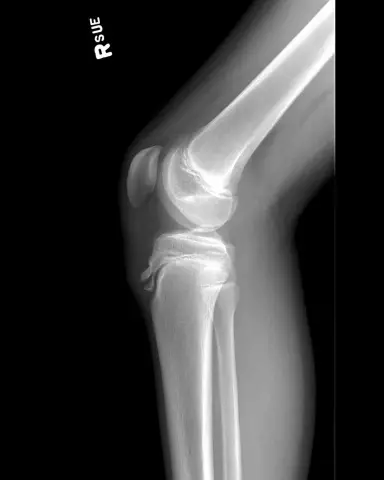- Author Rachel Wainwright [email protected].
- Public 2023-12-15 07:39.
- Last modified 2025-11-02 20:14.
Disease of Adamantiadis - Behcet
The content of the article:
- Causes and risk factors
- Symptoms
- Diagnostics
- Treatment
- Forecast
- Possible complications and consequences
- Prevention
Adamantiadis-Behcet's disease (Behcet's disease) belongs to the group of systemic vasculitis, manifested by ulceration of the mucous membranes of the genitals, mouth, eyes, skin (and later - internal organs and joints) caused by vascular pathology.
The disease is widespread, but the highest incidence rates are in Japan, the Mediterranean and the Middle East. Men are more susceptible to it; she usually makes her debut at the age of 20-40.

Ulceration of the oral mucosa in Adamantiadis-Behcet disease
Causes and risk factors
In Behcet's disease, medium and small sized veins and arteries are mainly affected. An inflammatory process develops in the walls of blood vessels, they are infiltrated by lymphocytes, neutrophils (intravascular conglomerates of neutrophils are characteristic), monocytes, and plasma cells. As a result, the walls of the affected vessels thicken, causing their narrowing or even obliteration, blood circulation in them is impaired. Violation of tissue trophism leads to various manifestations of the disease.
The reasons giving rise to the pathological process are currently unknown. The influence of the following factors is assumed:
- genetic mutations. The assumption is partly supported by the fact that the disease is most widespread among men in the Asian and Middle Eastern regions;
- toxic factors and infections. They cause damage to the tissues of the walls of blood vessels, and then maintain the inflammatory process in them;
- autoimmune mechanisms. In the body of patients suffering from Behcet's disease, antibodies to the cells of the oral mucosa are found, the content of circulating immune complexes (CIC) is increased.

One of the possible causes of Behcet's disease is genetic mutations
Symptoms
The first sign of Adamantiadis-Behcet's disease is characteristic ulceration of the mucous membranes of the genitals and the oral cavity.
Initially, vesicles appear on the mucous membranes - small bubbles filled with turbid contents. After a while, they burst, in their place appear bright pink aphthae with a diameter of several millimeters to several centimeters. Aphthae can merge with each other, leading to the appearance of erosion of a large area. Epithelialization of aft occurs within a month, often with the formation of scars. However, after a few months, they appear again.
A few weeks after suffering from ulcerative stomatitis, eye lesions occur:
- keratitis;
- conjunctivitis;
- uveitis;
- iridocyclitis;
- iritis.
Patients complain of increased photosensitivity, pain in the eyes, watery eyes, blurred vision, blepharospasm.

Behcet's disease is characterized by photophobia and eye pain
Skin symptoms appear:
- subungual felon;
- folliculitis;
- ulcers, papules, rash;
- erythema nodosum.

Skin rash with Behcet's disease
In about 50-60% of patients, the musculoskeletal system is affected. The most common injuries are the wrist, elbow, or knee joints. It is characteristic that the inflammatory process in them proceeds without destructive changes.
In some patients, Adamantiadis-Behcet disease occurs with neurological symptoms. It:
- increased intracranial pressure (manifested by headache, nausea, up to vomiting, edema of the optic nerve head);
- hemiparesis;
- tetraplegia;
- signs of spinal and stem disorders;
- meningoencephalitis.
The inflammatory process inside the vessels can lead to necrosis of the walls, and also increases the risk of blood clots. As a result, life-threatening conditions arise:
- thrombosis of the aorta, femoral, popliteal, ulnar arteries;
- pulmonary embolism (PE);
- thrombosis of the veins of the liver;
- thrombophlebitis of the lower extremities.
Much less often there are lesions of the lungs (infiltration pneumonia, pleurisy, hemoptysis), heart (endocarditis, myocarditis, pericarditis), organs of the gastrointestinal tract (colitis, enteritis).
Diagnostics
The main clinical and diagnostic criteria for Adamantiadis-Behcet disease:
- aphthous lesions of the genitals;
- often recurrent ulcerative stomatitis;
- vasculitis;
- uveitis;
- meningoencephalitis.
If there are three signs from this list, the patient is referred for a consultation with a rheumatologist. To confirm the diagnosis, a patergic test is performed. It lies in the fact that in case of Behcet's disease, a skin pustule forms at the site of the injection of the skin with a needle after 24-48 hours and reactive inflammation develops.
A general blood test reveals an increase in ESR, neutrophilic leukocytosis, moderate anemia. Changes in the coagulogram indicate an increase in the activity of the blood coagulation system. In the biochemical analysis of blood, an increase in the concentration of alpha-2-globulins, haptoglobin and fibrinogen is noted.

A general blood test in Behcet's disease shows an increase in ESR, moderate anemia, neutrophilic leukocytosis
A laboratory study of the immune status is carried out. The results usually reveal an increase in the level of immunoglobulins, CEC, as well as a decrease in the content of T-lymphocytes and T-helpers.
In the presence of an inflammatory process affecting the musculoskeletal system, arthroscopy, ultrasound and X-ray of the affected joints are performed.
Treatment
The therapy for Adamantiadis-Behcet's disease is complex and long-term. The standard regimen includes the appointment of drugs with an anti-gout effect, non-steroidal anti-inflammatory drugs, immunosuppressants, multivitamins, antibiotics or antiviral agents.
If after two months from the start of therapy, the patient's condition does not improve, then corticosteroid hormones are included in the regimen. If this course is ineffective, cytostatics are prescribed.

Long-term drug therapy is indicated for Adamantiadis-Behcet disease
The application of methods of extracorporeal detoxification is shown:
- intravascular laser blood irradiation;
- ultraviolet blood irradiation;
- hemosorption;
- plasmapheresis.
All these methods have a pronounced immunomodulatory effect.
With aphthous ulceration of the mucous membranes, they are treated with indomethacin or hepatrombin ointment.
Forecast
The prognosis for the isolated form of Behcet's disease, when only damage to the mucous membranes and skin is noted, is usually satisfactory. When the eyes, internal organs, and the central nervous system are involved in the pathological process, the prognosis worsens.
Possible complications and consequences
Against the background of Adamantiadis-Behcet's disease, the risk of developing secondary glaucoma, leading to optic nerve atrophy and persistent loss of vision, significantly increases. Blindness can develop as early as 2-3 years after the first symptoms appear.
Inflammation of the endothelium of blood vessels often causes gangrene of the lower extremities.
The danger is meningoencephalitis - it can lead to the formation of mental retardation, blindness, deafness, paralysis.
Prevention
Prevention of Adamantiadis-Behcet disease has not been developed, since the causes and mechanism of its development are unknown. Non-specific prevention are measures aimed at improving general immunity, as well as the timely detection and treatment of infectious and inflammatory diseases.
YouTube video related to the article:

Elena Minkina Doctor anesthesiologist-resuscitator About the author
Education: graduated from the Tashkent State Medical Institute, specializing in general medicine in 1991. Repeatedly passed refresher courses.
Work experience: anesthesiologist-resuscitator of the city maternity complex, resuscitator of the hemodialysis department.
The information is generalized and provided for informational purposes only. At the first sign of illness, see your doctor. Self-medication is hazardous to health!






